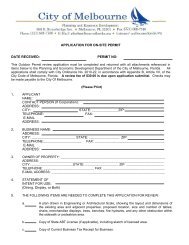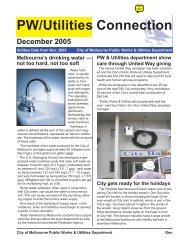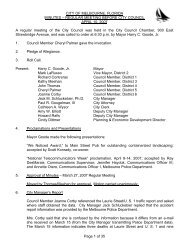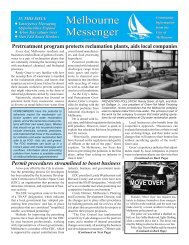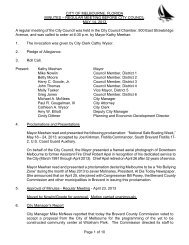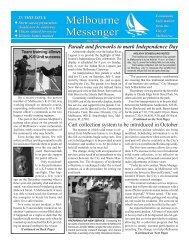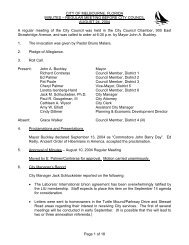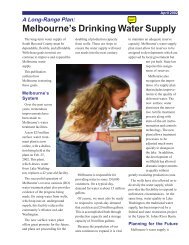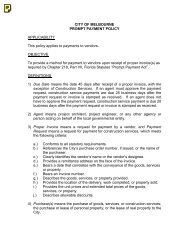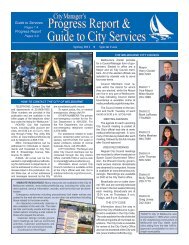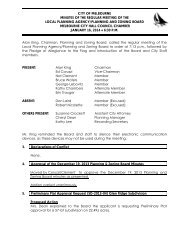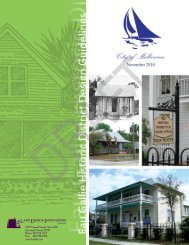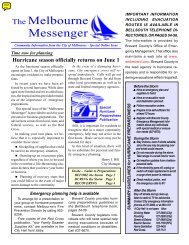March 26 - City of Melbourne, Florida
March 26 - City of Melbourne, Florida
March 26 - City of Melbourne, Florida
Create successful ePaper yourself
Turn your PDF publications into a flip-book with our unique Google optimized e-Paper software.
CITY OF MELBOURNE, FLORIDA<br />
MINUTES – REGULAR MEETING BEFORE CITY COUNCIL<br />
MARCH <strong>26</strong>, 2013<br />
Dr. Trenholm stated that many people say every fertilization is a potential pollution event<br />
when, in actuality, healthy turf grass takes up fertilizer regardless <strong>of</strong> rate or source. She<br />
summarized by stating that the model ordinance follows eight years <strong>of</strong> scientific research and<br />
provides the maximum amount <strong>of</strong> protection when there is a healthy turf grass system.<br />
Council Member John Thomas asked Dr. Trenholm her opinion on having a winter blackout<br />
period. Ms. Trenholm replied that it probably makes more sense than a summer blackout<br />
period throughout many locations in <strong>Florida</strong>. There are probably some slow release products<br />
that could be applied safely during the winter months, although she doesn’t have the<br />
scientific data to fully back that up.<br />
Vice Mayor Tasker referenced the portion <strong>of</strong> the study conducted in Gainesville and asked if<br />
the turf was adjacent to a water source. Dr. Trenholm replied by describing the methods and<br />
process used during the research project. Ms. Tasker said that the banks <strong>of</strong> the Indian River<br />
Lagoon are both sheer and gentle. She asked if that would have any affect. Dr. Trenholm<br />
replied that slope can make a difference, but healthy turf cover will mitigate both leaching<br />
and run<strong>of</strong>f events.<br />
Ms. Tasker asked about the run<strong>of</strong>f or leaching when fertilizer is applied to turf that is not<br />
healthy. Ms. Trenholm said every site is going to have slightly different characteristics in<br />
terms <strong>of</strong> soil, slope, rooting, and turf cover. She discussed the key to fertilizer application<br />
when establishing or repairing turf.<br />
Council Member Greg Jones asked if it is practical for the state to have one model ordinance<br />
for all regions in <strong>Florida</strong>. Dr. Trenholm explained that the model ordinance was designed to<br />
not be completely specific to different geographic regions. More localized adaptations are<br />
allowed in the model ordinance by referencing the Green Industries Best Management<br />
Practices.<br />
In response to Mr. Jones, Ms. Trenholm explained the phosphorus study, which was<br />
somewhat similar (to the nitrogen study). She added that native <strong>Florida</strong> soils may have<br />
ample phosphorus; however, many soils in developed areas are “fill soils.” Following the<br />
model ordinance and allowing for judicious application, up to .5 pounds per 1,000 square<br />
feet, is probably the best. A phosphorus deficiency will result in weakened roots, weakened<br />
turf.<br />
Ms. Tasker asked Dr. Trenholm what she thinks is adversely affecting the Indian River<br />
Lagoon. Dr. Trenholm commented that urbanization is affecting our water resources<br />
everywhere. Multiple components can go into non-point source pollution.<br />
Mayor Meehan stated that she also invited Troy Rice from the Indian River Lagoon Program<br />
(St. Johns River Water Management District).<br />
Troy Rice said that he is here to talk about the condition <strong>of</strong> the Indian River Lagoon. He<br />
reported that the state <strong>of</strong> the estuary is in crisis. Over 32,000 acres <strong>of</strong> sea grass have been<br />
Page 7 <strong>of</strong> <strong>26</strong>



